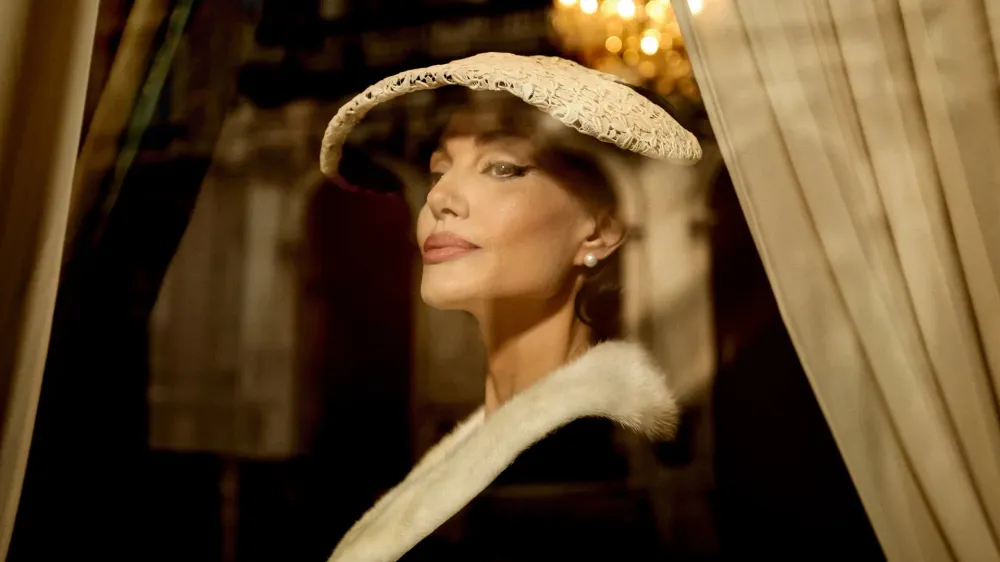“Vissi d'arte, vissi d'amore.”
Maria the final film in Pablo Larraín’s trilogy of twentieth century iconic women proves one thing about the Chilean director: he knows how to cast a leading lady. Angelina Jolie plays American-Greek operatic diva Maria Callas in a four-act film within a film where La Callas narrates her life to a non-existent journalist. Opening with a tableau of her body just hidden from view in her Parisian apartment in 1977, Larraín informs the audience that Maria is its own kind of opera. The tragic heroine transcendent in death – a martyr to the machinations of a world that refused to accept her transgressions or appeal for freedom.
Tragedy is Larraín’s brand for his trilogy which began with Jackie starring Natalie Portman as Jacqueline Bouvier Kennedy negotiating the aftermath of the death of her husband John F. Kennedy Jr., and was followed by Spencer starring Kristen Stewart as Diana, Princess of Wales, during a fraught weekend over Christmas spent with the Windsors. Each of the works is ostensibly an intimate look into defining women whose fame meant they were kept in iconic stasis – revered and reviled by a public eager to follow their every move. Where Maria is somewhat different is that although Callas, La Divina (the Divine one) had lived in the public eye, screenwriter Stephen Knight has chosen the last week of her life as the starting point for the non-linear biography. A point in Maria Callas’ all too short existence where she was mostly invisible, and, according to the film, so ill and drugged on quaaludes, that she no longer recognised the line between fantasy and reality.
With only her housekeeper Bruna (Alba Rohrwacher) and ever attendant butler Ferruccio (Pierfrancesco Favino) along with her poodles, keeping her company in her ornate apartment, Callas begins ‘narrating’ her autobiography and her epitaph to Mandrax (Kodi Smit-McPhee) a documentarian who exists when she needs to express her secrets. Callas is already a ghost – imperious and ephemeral – as Ed Lachman’s exquisitely shot black and white sequence of Callas singing an aria illustrates. She is timeless, but she is already past tense. Flashes of her famous roles; Medea, Carmen, Anna Bolena, Floria Tosca, Cio-Cio-San, Violetta, and Norma across stages from Milan, Paris, to New York cement Maria Callas’ position as a prima donna of the Operatic arts. But by 1977 Maria had been retired for three years after a series of poorly received revival performances.
The ‘Tigress’ recounts her life in chapters: ‘The Diva’, ‘An Important Truth’, ‘Curtain Call’, and ‘A Final Ascent’. Ed Lachman changes filmstock to signal what is happening ‘objectively’ in Callas’ world – warm toned 35mm echoing the look of European cinema in the 1970s. In sections set in the past he uses black and white. The ‘documentary’ section is in 16mm, and the home movies and stage performances switch between 16mm and 8mm creating a collaged reality. Pablo Larrían’s portrait of Maria Callas skirts around accuracy, “What is real and what is not is my business,” Maria tells Ferruccio and Larrían’s approach is similar – he is capturing the essence of the woman and the artist (although the two were often in competition with each other) and if such a thing is impossible then that comes down to Callas herself who could be both radically honest and necessarily dishonest.
Maria feels more exploitative than the previous films in the trilogy especially when Maria is desperately searching for her quaaludes or punishing herself with recordings of her damaged voice. Her lonely walks across Autumnal Paris have a stunning glow, as too her incredible home, but Maria is disconnected. Wearing black and with her eyes hidden behind her large framed glasses Maria’s journey to opera coach Jeffrey Tate (Stephen Ashfield) where she is testing herself to see if there a way to the stage again, is yet another kind of haunting. Tate is warm and easy with Maria, but he requires La Divina. Maria says she is looking for the “human voice,” – divinity now a memory kept on perfect recordings.
Knight’s screenplay plays out in vignettes. A young Maria and her sister Yakinthi (Aggelina Papadopoulou and Erophilie Panagiotarea) performing for Germain soldiers in Axis occupied Athens in 1940. Their mother Lista (Lydia Koniordou) possibly using Maria as a sex worker. The teenager already in training at the Greek National Conservatoire sings Bizet’s ‘Habanera’ from Carmen to a Nazi soldier spellbound by her skill. Maria Callas will sing ‘Habanera’ repeatedly, to sold out crowds all over the globe. A skip in time and La Callas is being photographed and harassed by crowds for cancelling performances.
Another skip in time and she is being celebrated at a party in Venice where she meets the “small and ugly” magnate Aristotle Onassis (Haluk Bilginer) in 1957. Onassis tells her frankly that she will be his because he will make her “feel something for the first time in her life” – Maria nods with polite scepticism and fascination. They are both married but she accepts his invitation to spend time with him on his yacht ‘The Christina’ and her husband Giovanni Battista Meneghini (Alessandro Bressanello) tags along. Like Lista, Battista’s main interest in Maria turned to how her fame benefitted him. Spending time with Onassis is the first ‘holiday’ Maria has had in her life. The cigar chomping Aristo seducing her with a sense of wickedness she sees through. He tells her he loves to steal art and beauty showing her a rare sculpture of the Greek Olympian Hermes (with who he identifies). Maria laughs that he assumes he needs to resort to being a thief – she is not an objet d’art.
Maria Callas spoke to David Frost in 1970 in an incredibly candid interview where she stated, “There are two people in me. I would like to be Maria, but there is the Callas that I have to live up to.” She also spoke of her ‘friendship’ with Onassis, who by that stage had married Jacqueline Bouvier Kennedy. There are scenes in the film which attempt to investigate how essential and potentially damaging their many years long affair was. Onassis taking her to John F. Kennedy’s birthday party where Marilyn Monroe sang to him. She quips that Monroe can’t sing. He responds no one is listening to Monroe’s voice, just as no one looks at Maria’s body when she is on stage. Maria’s Aristo revels in his coarseness. People must put up with him because he is immensely wealthy – he is a being made of hard work like her, but Maria’s status is predicated on her pleasing the public. She meets JFK (again played by Caspar Phillipson) where he speaks to her about Onassis and makes the implication that as his mistress (his ‘whatever’), Maria should be aware that Aristotle has invited Jackie to see his El Greco on his yacht – placed in his bedroom. “We are not friends,” she tells Kennedy based on the fact they exist in a circle of adultery protected by their power.
Angelina Jolie did several months of vocal training to play Callas and her voice is sometimes mixed with recordings of Callas to create a specific timbre. The training pays off especially in the penultimate scene where Jolie is sublime. As essential as it is for Jolie to appear as if she knows how to embody an artist of Callas’ stature in performance mode, the real strength of her portrayal of Maria is in the smaller warmer moments where she allows herself her ‘human voice’ with Bruna and Ferruccio.
“Greeks are not afraid of death,” says Callas – and the way Larraín structures Maria Callas’ life story it appears that she is constantly inviting Thanatos. If Spencer was in part a ghost story, Maria is an extended death scene. The aesthetic of death shrouds Callas as she hallucinates her lovely and unlovely life. Larraín’s work has the advantage of sublime cinematography, tremendous production design by Guy Hendrix Dyas, sumptuous costume design by Massimo Cantini Parrini, and Angelina Jolie’s most accomplished performance in years.
“I do not cry on tragedies until they happen,” Maria Callas said in her last major interview. Stephen Knight and Pablo Larraín barely allow their Maria a moment where she isn’t steeped in some manner of pain; psychological, romantic, familial, artistic, or physical. Maria is exalted and exploitative: a marvellous piece of morbidity. Maria Callas’ rarefied talent sits behind Larraín’s managed misery. “There is no life off the stage,” is the leitmotif of Maria – a note too sour for one as extolled as La Callas.
Director: Pablo Larraín
Cast: Angelina Jolie, Valeria Golino, Kodi Smit-McPhee
Writer: Steven Knight
Producers: Jonas Dornbach, Janine Jackowski, Juan de Dios Larrain, Pablo Larraín, Lorenzo Mieli
Cinematography: Edward Lachman
Editor: Sofia Subercaseaux

